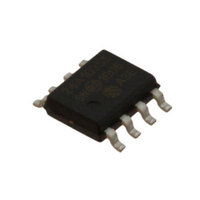24AA1025-I/SN Microchip Technology, 24AA1025-I/SN Datasheet - Page 7

24AA1025-I/SN
Manufacturer Part Number
24AA1025-I/SN
Description
IC EEPROM 1MBIT 400KHZ 8SOIC
Manufacturer
Microchip Technology
Datasheet
1.24FC1025T-ISM.pdf
(28 pages)
Specifications of 24AA1025-I/SN
Format - Memory
EEPROMs - Serial
Memory Type
EEPROM
Memory Size
1M (128K x 8)
Speed
100kHz, 400kHz
Interface
I²C
Voltage - Supply
1.7 V ~ 5.5 V
Operating Temperature
-40°C ~ 85°C
Package / Case
8-SOIC (3.9mm Width)
Lead Free Status / RoHS Status
Lead free / RoHS Compliant
Lead Free Status / RoHS Status
Lead free / RoHS Compliant, Lead free / RoHS Compliant
Available stocks
Company
Part Number
Manufacturer
Quantity
Price
Company:
Part Number:
24AA1025-I/SN
Manufacturer:
PHILIPS
Quantity:
2 000
Company:
Part Number:
24AA1025-I/SN
Manufacturer:
MCP
Quantity:
3 000
Part Number:
24AA1025-I/SN
Manufacturer:
MICROCHIP/微芯
Quantity:
20 000
4.0
The following bus protocol has been defined:
• Data transfer may be initiated only when the bus
• During data transfer, the data line must remain
Accordingly, the following bus conditions have been
defined
4.1
Both data and clock lines remain high.
4.2
A high-to-low transition of the SDA line while the clock
(SCL) is high determines a Start condition. All
commands must be preceded by a Start condition.
4.3
A low-to-high transition of the SDA line while the clock
(SCL) is high determines a Stop condition. All
operations must end with a Stop condition.
4.4
The state of the data line represents valid data when,
after a Start condition, the data line is stable for the
duration of the high period of the clock signal.
FIGURE 4-1:
FIGURE 4-2:
2011 Microchip Technology Inc.
is not busy.
stable whenever the clock line is high. Changes in
the data line while the clock line is high will be
interpreted as a Start or Stop condition.
SCL
SDA
SCL
SDA
(Figure
(A)
BUS CHARACTERISTICS
Bus Not Busy (A)
Start Data Transfer (B)
Stop Data Transfer (C)
Data Valid (D)
Condition
Start
(B)
4-1).
1
The transmitter must release the SDA line at this
point allowing the receiver to pull the SDA line low
to acknowledge the previous eight bits of data.
DATA TRANSFER SEQUENCE ON THE SERIAL BUS
ACKNOWLEDGE TIMING
2
3
Data from transmitter
24AA1025/24LC1025/24FC1025
4
Acknowledge
Address or
Valid
5
(D)
6
To Change
7
Allowed
Data
Acknowledge
The data on the line must be changed during the low
period of the clock signal. There is one bit of data per
clock pulse.
Each data transfer is initiated with a Start condition and
terminated with a Stop condition. The number of the
data bytes transferred between the Start and Stop
conditions is determined by the master device.
4.5
Each receiving device, when addressed, is obliged to
generate an Acknowledge signal after the reception of
each byte. The master device must generate an extra
clock pulse which is associated with this Acknowledge
bit.
A device that acknowledges must pull-down the SDA
line during the Acknowledge clock pulse in such a way
that the SDA line is stable low during the high period of
the acknowledge related clock pulse. Of course, setup
and hold times must be taken into account. During
reads, a master must signal an end of data to the slave
by NOT generating an Acknowledge bit on the last byte
that has been clocked out of the slave. In this case, the
slave (24XX1025) will leave the data line high to enable
the master to generate the Stop condition.
8
Note:
Bit
9
Acknowledge
The 24XX1025 does not generate any
Acknowledge bits if an internal program-
ming cycle is in progress, however, the
control byte that is being polled must
match the control byte used to initiate the
write cycle.
(D)
1
The receiver must release the SDA line at this
point so the transmitter can continue sending
data.
Data from transmitter
2
3
DS21941H-page 7
Condition
Stop
(C)
(A)














